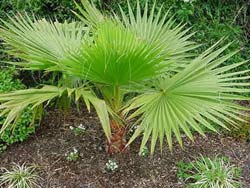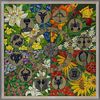Flower EncyclopediaENTER THE WORLD OF FLOWERS |
Other News
Washingtonia (part 1)
Category: Palms
26 Jul : 13:06
To view pictures click on them




 The genus includes two sail palms, which resemble the external Pritchardia, whose subgenus were up in 1879. Washingtonia develop healthy, swollen at the base soliterni stems, which become very high and constitute almost round fans, which unlike many species of palms, not less, when they reached a certain age, but turned down, and wrap the trunk and put one above another petticoats. Hence the exact American names.
The genus includes two sail palms, which resemble the external Pritchardia, whose subgenus were up in 1879. Washingtonia develop healthy, swollen at the base soliterni stems, which become very high and constitute almost round fans, which unlike many species of palms, not less, when they reached a certain age, but turned down, and wrap the trunk and put one above another petticoats. Hence the exact American names.Family - Arecaceae / Palm.
Washington is one of the most popular indoor plants worldwide. She was born in the desert parts of Arizona and California and decorative leaf plant. Palm Washington is tall and beautiful, growing rapidly. With large, round leaves, as it is specific in that older leaves do not fall off her and dropped.
Several types:
• Washingtonia filifera
It reaches a height over 20 meters in diameter trunk handles 1 m of green to gray-green leaves are very spiny part and the segments were cut from the top. Between segments hang very long, white, partially curly fibers. Fruits are oval, long okay. 6 millimeters and black and brown.
• Washingtonia robusta
Unlike the previous species, the stem, which basically has the shape of the elephant leg has a diameter of only 25 cm without leaf bases, it is rough and grayish-brown color. The edges of the leaf stalks of young plants are completely covered with thorns. The upper part of the handles are red-brown hue. The threads between the leaf segments and leaf stalks of weapons decreased with advancing age.
The base of the leaf stalks have a trunk with a picturesque appearance. Vashingtoniite grow quite rapidly and in a large vessel can reach over 2 meters wide and 3 meters in height.
Cultivation: Vashingtoniite favorites are ornamental plants and are suitable for cultivation in pots and containers. As typical for sdudena house plant in winter they must be very warm and dark place. Plants form a large root mass and therefore must be transferred to larger vessels earlier than other families. Transplant, when necessary, in a food composting grass or soil.
Family: Arecaceae, palm.
Origin: Motherland of the palm is yugpzapadnata northwest Mexico and part of the United States. It occurs along with other vegetation in the area in valleys near water bodies, but also in dry areas.
Mestorastene: old copies of sunshine and a light to young polusenchesto.
Substrate: Optimal soil or clay garden soil with sand.
Irrigation, fertilization: In the period of growth is watered thoroughly and August natoryava in 14 days with reduced doses. Important: do not pour in the heart of the plant to incorruptible.
Seed multiplication requires much time. To expedite some sprouting seeds dipped in hot water.
Winter: The light at 5-8oS. Watered a little. Young plants to transplant in spring, but only if the old tuff push out of court. Good drainage is needed!
Pests, Diseases: Scale insects.
Warning: risk of injury from thorns in the leaf stalks.
Tips for Design: Washington is soliterno plant that grows very quickly and requires much space.
| pots and containers leaf stalks picturesque appearance plant palm grayish brown color |
Comments are turned off for this item0
| pots and containers leaf stalks picturesque appearance plant palm grayish brown color |























































